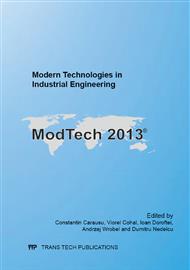p.185
p.190
p.196
p.201
p.206
p.212
p.218
p.223
p.228
Studies Regarding Production of the Moulding Form from Calcined Gypsum
Abstract:
In the pressing form made from calcined gypsum fixed in metal, wax can be cast with pressure. The device used to tide the pressing form should not bend. If the handling work is done carefully and correct one pressing form made from gypsum can be used for multiple wax models. To be used in construction the pressing forms, calcined gypsum must meet certain requirements regarding its constitution and functionality. To provide these requirements research work must be done to investigate characteristics such as: minimum compressive strength (wet and dry state), hardening time of calcined gypsum, gypsum dilatation after curing. To produce the pressing forms from calcined gypsum the following methods and operations have been used: operations concerning production of gypsum with the best physicochemical and mechanical properties in order to be used for construction of pressing forms (determining the quality of gypsum based on water and plaster ratio; establishing the influence of epoxy and curing solution on the mechanical resistance of the obtained gypsum; determining the influence of lime, boric acid, zinc chloride, sodium chloride on the hardening period of calcined gypsum); production of the models from wood and metal; fixing the model on the gypsum cushion; finding on the model the separation line and restrict the area used for gypsum moulding; applying grease on the model, on the plate under the model, on the walls and on all parts that come in contact with liquid gypsum to be poured; preparation of the gypsum solution.
Info:
Periodical:
Pages:
206-211
Citation:
Online since:
November 2013
Authors:
Keywords:
Price:
Сopyright:
© 2014 Trans Tech Publications Ltd. All Rights Reserved
Share:
Citation:


